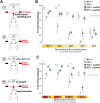Bone marrow cell transplantation restores olfaction in the degenerated olfactory bulb
- PMID: 22745504
- PMCID: PMC6622346
- DOI: 10.1523/JNEUROSCI.0260-12.2012
Bone marrow cell transplantation restores olfaction in the degenerated olfactory bulb
Abstract
Bone marrow contains heterogeneous cell types including end-lineage cells, committed tissue progenitors, and multipotent stem/progenitor cells. The immense plasticity of bone marrow cells allows them to populate diverse tissues such as the encephalon, and give rise to a variety of cell types. This unique plasticity makes bone marrow-derived cells good candidates for cell therapy aiming at restoring impaired brain circuits. In the present study, bone marrow cells were transplanted into P20 mice that exhibit selective olfactory degeneration in adulthood between P60 and P150. These animals, the so-called Purkinje Cell Degeneration (PCD) mutant mice, suffer from a progressive and specific loss of a subpopulation of principal neurons of the olfactory bulb, the mitral cells (MCs), sparing the other principal neurons, the tufted cells. As such, PCD mice constitute an interesting model to evaluate the specific role of MCs in olfaction and to test the restorative function of transplanted bone marrow-derived cells. Using precision olfactometry, we revealed that mutant mice lacking MCs exhibited a deficit in odorant detection and discrimination. Remarkably, the transplantation of wild-type bone marrow-derived cells into irradiated PCD mutant mice generated a large population of microglial cells in the olfactory bulb and reduced the degenerative process. The alleviation of MC loss in transplanted mice was accompanied by functional recovery witnessed by significantly improved olfactory detection and enhanced odor discrimination. Together, these data suggest that: (1) bone marrow-derived cells represent an effective neuroprotective tool to restore degenerative brain circuits, and (2) MCs are necessary to encode odor concentration and odor identity in the mouse olfactory bulb.
Figures


Similar articles
-
The engraftment and differentiation of transplanted bone marrow-derived cells in the olfactory bulb after methimazole administration.Acta Otolaryngol. 2013 Sep;133(9):951-6. doi: 10.3109/00016489.2013.803153. Epub 2013 Jul 4. Acta Otolaryngol. 2013. PMID: 23822107
-
Prenatal and Early Postnatal Odorant Exposure Heightens Odor-Evoked Mitral Cell Responses in the Mouse Olfactory Bulb.eNeuro. 2017 Sep 26;4(5):ENEURO.0129-17.2017. doi: 10.1523/ENEURO.0129-17.2017. eCollection 2017 Sep-Oct. eNeuro. 2017. PMID: 28955723 Free PMC article.
-
Bone marrow stem cell transplantation to olfactory epithelium.Ann Otol Rhinol Laryngol. 2010 Aug;119(8):535-40. doi: 10.1177/000348941011900806. Ann Otol Rhinol Laryngol. 2010. PMID: 20860279
-
Newborn neurons in the adult olfactory bulb: unique properties for specific odor behavior.Behav Brain Res. 2012 Feb 14;227(2):480-9. doi: 10.1016/j.bbr.2011.08.001. Epub 2011 Aug 6. Behav Brain Res. 2012. PMID: 21843557 Review.
-
Relation of the volume of the olfactory bulb to psychophysical measures of olfactory function.Eur Arch Otorhinolaryngol. 2016 Jan;273(1):1-7. doi: 10.1007/s00405-014-3325-7. Epub 2014 Oct 12. Eur Arch Otorhinolaryngol. 2016. PMID: 25308243 Review.
Cited by
-
[Future therapeutic strategies for olfactory disorders: electrical stimulation, stem cell therapy, and transplantation of olfactory epithelium-an overview].HNO. 2021 Aug;69(8):623-632. doi: 10.1007/s00106-021-01060-x. Epub 2021 May 14. HNO. 2021. PMID: 33988723 Free PMC article. Review. German.
-
BDNF over-expression increases olfactory bulb granule cell dendritic spine density in vivo.Neuroscience. 2015 Sep 24;304:146-60. doi: 10.1016/j.neuroscience.2015.07.056. Epub 2015 Jul 23. Neuroscience. 2015. PMID: 26211445 Free PMC article.
-
A "Drug-Dependent" Immune System Can Compromise Protection against Infection: The Relationships between Psychostimulants and HIV.Viruses. 2021 Apr 21;13(5):722. doi: 10.3390/v13050722. Viruses. 2021. PMID: 33919273 Free PMC article. Review.
-
Experimental neurotransplantation treatment for hereditary cerebellar ataxias.Cerebellum Ataxias. 2016 Apr 4;3:7. doi: 10.1186/s40673-016-0045-3. eCollection 2016. Cerebellum Ataxias. 2016. PMID: 27047666 Free PMC article. Review.
-
Olfactory bulb plasticity ensures proper olfaction after severe impairment in postnatal neurogenesis.Sci Rep. 2017 Jul 18;7(1):5654. doi: 10.1038/s41598-017-05970-1. Sci Rep. 2017. PMID: 28720887 Free PMC article.
References
-
- Álvarez-Dolado M. Cell fusion: biological perspectives and potential for regenerative medicine. Front Biosci. 2007;12:1–12. - PubMed
-
- Álvarez-Dolado M, Pardal R, García-Verdugo JM, Fike JR, Lee HO, Pfeffer K, Lois C, Morrison SJ, Alvarez-Buylla A. Fusion of bone-marrow-derived cells with Purkinje neurons, cardiomyocytes and hepatocytes. Nature. 2003;425:968–973. - PubMed
-
- Bae JS, Han HS, Youn DH, Carter JE, Modo M, Schuchman EH, Jin HK. Bone marrow-derived mesenchymal stem cells promote neuronal networks with functional synaptic transmission after transplantation into mice with neurodegeneration. Stem Cells. 2007;25:1307–1316. - PubMed
-
- Bartolomei JC, Greer CA. The organization of piriform cortex and the lateral olfactory tract following the loss of mitral cells in PCD mice. Exp Neurol. 1998;154:537–550. - PubMed
-
- Bathellier B, Buhl DL, Accolla R, Carleton A. Dynamic ensemble odor coding in the mammalian olfactory bulb: sensory information at different timescales. Neuron. 2008;57:586–598. - PubMed
Publication types
MeSH terms
Substances
LinkOut - more resources
Full Text Sources
Medical
Research Materials
